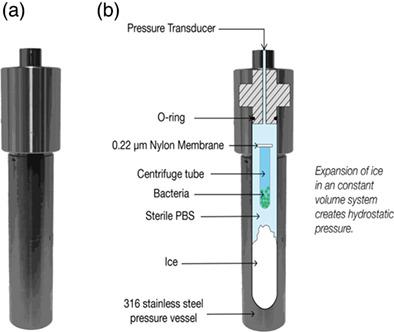当前位置:
X-MOL 学术
›
J. Food Saf.
›
论文详情
Our official English website, www.x-mol.net, welcomes your
feedback! (Note: you will need to create a separate account there.)
Viability of Listeria monocytogenes and Salmonella Typhimurium after isochoric freezing
Journal of Food Safety ( IF 1.9 ) Pub Date : 2020-08-10 , DOI: 10.1111/jfs.12840 David F. Bridges 1 , Cristina Bilbao‐Sainz 2 , Matthew J. Powell‐Palm 3 , Tina Williams 4 , Delilah Wood 4 , Amanda J. G. Sinrod 2 , Gideon Ukpai 3 , Tara H. McHugh 2 , Boris Rubinsky 3 , Vivian C. H. Wu 1
Journal of Food Safety ( IF 1.9 ) Pub Date : 2020-08-10 , DOI: 10.1111/jfs.12840 David F. Bridges 1 , Cristina Bilbao‐Sainz 2 , Matthew J. Powell‐Palm 3 , Tina Williams 4 , Delilah Wood 4 , Amanda J. G. Sinrod 2 , Gideon Ukpai 3 , Tara H. McHugh 2 , Boris Rubinsky 3 , Vivian C. H. Wu 1
Affiliation

|
Isochoric freezing, different from isobaric (conventional) freezing, allows for storage below freezing temperatures without significant damage from ice formation. While several types of tissues have been successfully stored in sub‐zero isochoric conditions, it is unknown how isochoric freezing affects pathogenic microorganisms. Thus, the objective of this study was to investigate the survival of Salmonella Typhimurium and Listeria monocytogenes at below freezing storage (<0°C) in isochoric conditions. Tested conditions included storage at −4, −7, and −15°C for 24 hr and at −15°C for 1, 2, 3, 6, 12, and 24 hr. A comparison of bacterial survival during isobaric freezing was included with every trial. Additionally, bacterial cells were examined for morphological damage using transmission electron and field‐emission scanning electron microscopes. Isochoric freezing at −15°C for 24 hr reduced both species of bacteria down to unrecoverable levels and maximum efficacy achieved after the 6 hr timepoint for L. monocytogenes and the 12 hr timepoint for S. Typhimurium. When viewed using electron microscopy, S. Typhimurium cells were noticeably disfigured with regions of cytosol separated from the cell wall. The results of this study demonstrate that isochoric freezing is capable of substantial levels of pathogen reduction. Unlike conventional nonthermal interventions, isochoric freezing does not require additional devices such as elevated pressure machines or pulsed electric fields and can be achieved with simple, inexpensive, rigid closed volume containers such as household freezers or commercial cold storage facilities.
中文翻译:

等容冷冻后单核细胞增生李斯特菌和鼠伤寒沙门氏菌的生存力
与等压(常规)冷冻不同,等速冷冻可以在低于冷冻温度下储存,而不会因冰的形成而造成重大损害。虽然几种类型的组织已成功地存储在零等压条件下,但未知等速冷冻如何影响病原微生物。因此,本研究的目的是调查鼠伤寒沙门氏菌和李斯特菌的存活在等容条件下低于冰点(<0°C)。测试条件包括在−4,−7和-15°C下保存24小时,并在−15°C下保存1、2、3、6、12和24小时。每个试验都包括同量异位冷冻过程中细菌存活率的比较。此外,使用透射电子显微镜和场发射扫描电子显微镜检查细菌细胞的形态损伤。在-15℃下放置24小时等容冷冻减少细菌的两个物种下降到不可恢复的水平和最大功效的6小时时间点为后获得单增李斯特菌和用于12小时时间点S.鼠伤寒沙门氏菌。当使用电子显微镜观察时,S。鼠伤寒细胞明显变形,胞浆区域与细胞壁分离。这项研究的结果表明,等速冷冻能够显着降低病原体水平。与常规的非热干预不同,等速冷冻不需要诸如高压机器或脉冲电场之类的附加设备,并且可以通过简单,廉价,刚性的封闭容积容器(如家用冷冻机或商业冷藏设施)来实现。
更新日期:2020-10-08
中文翻译:

等容冷冻后单核细胞增生李斯特菌和鼠伤寒沙门氏菌的生存力
与等压(常规)冷冻不同,等速冷冻可以在低于冷冻温度下储存,而不会因冰的形成而造成重大损害。虽然几种类型的组织已成功地存储在零等压条件下,但未知等速冷冻如何影响病原微生物。因此,本研究的目的是调查鼠伤寒沙门氏菌和李斯特菌的存活在等容条件下低于冰点(<0°C)。测试条件包括在−4,−7和-15°C下保存24小时,并在−15°C下保存1、2、3、6、12和24小时。每个试验都包括同量异位冷冻过程中细菌存活率的比较。此外,使用透射电子显微镜和场发射扫描电子显微镜检查细菌细胞的形态损伤。在-15℃下放置24小时等容冷冻减少细菌的两个物种下降到不可恢复的水平和最大功效的6小时时间点为后获得单增李斯特菌和用于12小时时间点S.鼠伤寒沙门氏菌。当使用电子显微镜观察时,S。鼠伤寒细胞明显变形,胞浆区域与细胞壁分离。这项研究的结果表明,等速冷冻能够显着降低病原体水平。与常规的非热干预不同,等速冷冻不需要诸如高压机器或脉冲电场之类的附加设备,并且可以通过简单,廉价,刚性的封闭容积容器(如家用冷冻机或商业冷藏设施)来实现。











































 京公网安备 11010802027423号
京公网安备 11010802027423号